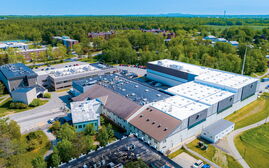Wind-energy firms to invest $100M in UMaine Aqua Ventus project
 Courtesy / University of Maine
The University of Maine will work with a joint venture of Diamond Offshore Wind and RWE Renewables to develop the university's wind technology demonstration project, shown here in a rendering, about 2 miles from Monhegan Island.
Courtesy / University of Maine
The University of Maine will work with a joint venture of Diamond Offshore Wind and RWE Renewables to develop the university's wind technology demonstration project, shown here in a rendering, about 2 miles from Monhegan Island.
Two firms with global expertise in offshore wind energy are partnering with the University of Maine on its floating offshore wind technology demonstration project.
Diamond Offshore Wind and RWE Renewables will invest $100 million to build the project and help demonstrate the technology at full scale, according to a news release Wednesday.
The project is projected to produce more than $150 million in total economic output and create hundreds of Maine-based jobs during the construction period.
The two new partners are already responsible for nearly a quarter of the world’s offshore wind capacity.
“Diamond Offshore Wind and RWE Renewables bring global expertise in offshore wind project development and construction, and we look forward to working with them to demonstrate UMaine’s floating hull technology in Maine waters,” Habib Dagher, executive director of UMaine’s Advanced Structures and Composites Center, said in the release.
“Our design is ideally suited for deep-water deployment anywhere and has the potential to play a significant role in global efforts to decrease dependence on fossil fuels.”
Diamond Offshore Wind is a subsidiary of the Mitsubishi Corp. and RWE Renewables says it's the world's second-largest company in offshore wind energy.
Cianbro Corp., based in Pittsfield, is another partner on the project.
The New England Aqua Ventus project consists of a semi-submersible concrete floating platform that will support a commercial 10–to 12-megawatt wind turbine, which will be deployed in a state-designated area 2 miles south of Monhegan Island and 14 miles from the Maine coast.
The purpose of the project is to further evaluate the floating technology, monitor environmental factors and develop best practices for offshore wind to coexist with traditional marine activities. The turbine will supply clean, renewable electricity to the Maine grid.
The project uses a hull technology called VolturnUS, which was invented by the Advanced Structures and Composites Center.
As the developer, New England Aqua Ventus will own and manage all aspects of permitting, construction and assembly, deployment and ongoing operations for the project. UMaine’s Advanced Structures and Composites Center will continue with design and engineering, research and development and post-construction monitoring.
Construction, following all permitting, is expected to be completed in 2023.
Engage with maritime users
A priority for the new development team is to work with the fishing industry, coastal communities and others to ensure the new energy source can provide economic growth for Maine and not interfere with other maritime uses.
Since 2008, the University of Maine has researched floating offshore wind technology as a solution to Maine’s dependence on imported fossil fuels. After winning funding from the U.S. Department of Energy, the university worked with Cianbro to build and deploy the first grid-connected offshore wind turbine in the U.S. in 2013, a one-eighth scale prototype of its VolturnUS floating hull technology.
The success of the project led to additional funding from the DOE to further advance the VolturnUS technology, which has been issued 43 patents to date. The university and Cianbro sought to partner with an offshore wind developer to further demonstrate the technology on a commercial scale. UMaine will continue to own its VolturnUS floating hull intellectual property and license it to NEAV for this project.
“Maine’s offshore wind resource potential is 36 times greater than the state’s electricity demand, making this project so significant for Maine’s clean energy future,” U.S. Sens. Susan Collins and Angus King and U.S. Reps. Chellie Pingree and Jared Golden said in a joint statement.
Said Daniel Simmons, assistant secretary of energy efficiency and renewable energy for the U.S. Department of Energy, “This complements the investment of research, development and demonstration funding from DOE to advance innovation in a floating design for offshore wind.”
Gov. Janet Mills said the new public-private partnership, joining world-class offshore wind developers and the University of Maine, puts the state on track to be home to the nation’s first floating offshore wind project, reflecting major economic growth opportunity of the clean energy economy.
“This is a significant milestone for the University of Maine, the offshore wind research team and the state of Maine,” UMaine President Joan Ferrini-Mundy said.
Multiple partners
NEAV will continue to involve Maine companies in permitting, construction and assembly, deployment, and ongoing operations and maintenance of the project. In addition, NEAV has committed to working with UMaine on research, development and design to take the technology elsewhere in the U.S. and the world.
The concrete hulls are designed to be built in communities adjacent to potential projects, generating local construction jobs and other benefits during the building and assembly phase.
“Cianbro has been a founding member of the Aqua Ventus team for over 10 years and we remain deeply supportive and committed to the development of offshore wind in Maine,” said Cianbro Chairman Pete Vigue. “We look forward to working with the NEAV team and all related stakeholders to complete the initial demonstration unit.”
The developers also will work with the University of Maine System, the Maine Community College System and Maine Maritime Academy to attract K–12 students to science, engineering and business programs, prepare college students and help to create a skilled workforce in Maine with the technical skills necessary to support offshore wind development and operation.
“We are pleased to partner with the university to bring its ideas for floating offshore wind to fruition,” said Chris Wissemann of Diamond Offshore Wind. “Together with RWE, our engineers conducted an extensive due-diligence review of UMaine’s VolturnUS floating wind technology, and believe it is a world leader in floating wind that reduces costs and creates local jobs.”
Added Sven Utermöhlen, chief operating officer of wind offshore global for RWE Renewables, “We see great potential for floating wind farms worldwide, especially in countries like the U.S., with deeper coastal waters.”
Last November, the state Public Utilities Commission voted unanimously to approve a 20-year contract under which Central Maine Power Co. will purchase electricity generated by the Aqua Ventus project.
VolturnUS is the first grid-connected offshore wind turbine in the Americas, and incorporates 30 pending patents for its semi-submersible concrete hull technology. The turbine was designed and built at UMaine, assembled at Cianbro’s facility in Brewer, and launched in 2013.












0 Comments